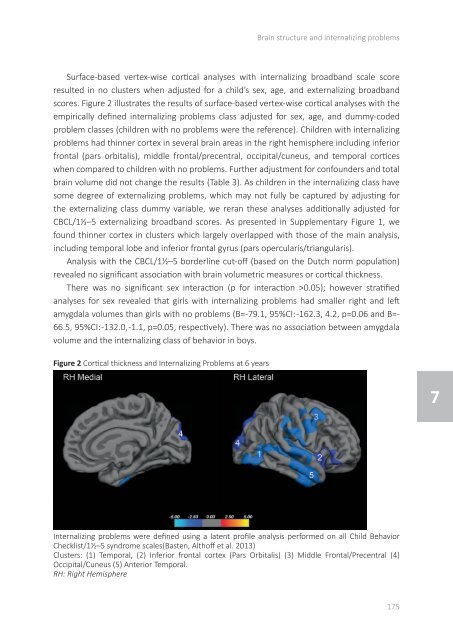On the Spectrum
2lm5UyR
2lm5UyR
You also want an ePaper? Increase the reach of your titles
YUMPU automatically turns print PDFs into web optimized ePapers that Google loves.
Brain structure and internalizing problems<br />
Surface-based vertex-wise cortical analyses with internalizing broadband scale score<br />
resulted in no clusters when adjusted for a child’s sex, age, and externalizing broadband<br />
scores. Figure 2 illustrates <strong>the</strong> results of surface-based vertex-wise cortical analyses with <strong>the</strong><br />
empirically defined internalizing problems class adjusted for sex, age, and dummy-coded<br />
problem classes (children with no problems were <strong>the</strong> reference). Children with internalizing<br />
problems had thinner cortex in several brain areas in <strong>the</strong> right hemisphere including inferior<br />
frontal (pars orbitalis), middle frontal/precentral, occipital/cuneus, and temporal cortices<br />
when compared to children with no problems. Fur<strong>the</strong>r adjustment for confounders and total<br />
brain volume did not change <strong>the</strong> results (Table 3). As children in <strong>the</strong> internalizing class have<br />
some degree of externalizing problems, which may not fully be captured by adjusting for<br />
<strong>the</strong> externalizing class dummy variable, we reran <strong>the</strong>se analyses additionally adjusted for<br />
CBCL/1½–5 externalizing broadband scores. As presented in Supplementary Figure 1, we<br />
found thinner cortex in clusters which largely overlapped with those of <strong>the</strong> main analysis,<br />
including temporal lobe and inferior frontal gyrus (pars opercularis/triangularis).<br />
Analysis with <strong>the</strong> CBCL/1½–5 borderline cut-off (based on <strong>the</strong> Dutch norm population)<br />
revealed no significant association with brain volumetric measures or cortical thickness.<br />
There was no significant sex interaction (p for interaction >0.05); however stratified<br />
analyses for sex revealed that girls with internalizing problems had smaller right and left<br />
amygdala volumes than girls with no problems (B=-79.1, 95%CI: -162.3, 4.2, p=0.06 and B=-<br />
66.5, 95%CI: -132.0, -1.1, p=0.05, respectively). There was no association between amygdala<br />
volume and <strong>the</strong> internalizing class of behavior in boys.<br />
Figure 2 Cortical thickness and Internalizing Problems at 6 years<br />
7<br />
Internalizing problems were defined using a latent profile analysis performed on all Child Behavior<br />
Checklist/1½–5 syndrome scales(Basten, Althoff et al. 2013)<br />
Clusters: (1) Temporal, (2) Inferior frontal cortex (Pars Orbitalis) (3) Middle Frontal/Precentral (4)<br />
Occipital/Cuneus (5) Anterior Temporal.<br />
RH: Right Hemisphere<br />
175


